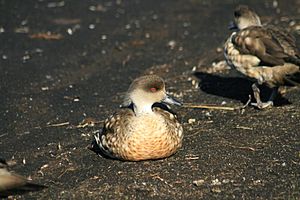Patagonian crested duck facts for kids
Quick facts for kids Patagonian crested duck |
|
|---|---|
 |
|
| Scientific classification |
|
| Kingdom: | Animalia |
| Phylum: | Chordata |
| Class: | Aves |
| Order: | Anseriformes |
| Family: | Anatidae |
| Genus: | Lophonetta |
| Species: | |
| Subspecies: |
L. s. specularioides
|
| Trinomial name | |
| Lophonetta specularioides specularioides King, 1828
|
|
| Synonyms | |
|
|
The Patagonian crested duck is a type of duck found in South America. It's also called the southern crested duck or the grey duck, especially in the Falkland Islands. This duck is one of two main kinds, or subspecies, of the crested duck.
Contents
What Does the Patagonian Crested Duck Look Like?
This duck has a grey chin, neck, and face. Its body feathers are a mix of brown and grey, giving it a spotted or "mottled" look. Its eyes are red with black pupils, which are the dark centers of the eyes. The top of its head and the feathers around its eyes are dark brown or black. Its tail feathers are also dark, sometimes black.
The Patagonian crested duck has a black beak and dark grey to black legs with webbed feet. It is a medium-sized duck, usually about 50 to 60 centimeters (about 20-24 inches) long. Both male and female ducks weigh around 1 kilogram (about 2.2 pounds), but males are often a bit bigger.
This duck sheds its feathers, or "moults," twice a year. It also sheds its wing feathers once a year.
Young Patagonian Crested Ducks
Young ducks have smaller crests than adult ducks, or sometimes no crest at all. Their faces are browner than the adults'. The feathers on their belly are much whiter, and their lower beak is a pinkish color.
Where Do Patagonian Crested Ducks Live?
The Patagonian crested duck lives in southern South America. You can find it in countries like Chile, Argentina, and the Falkland Islands.
These ducks can live near the coast or in freshwater areas. They make their homes in marshlands, swamps, lakes, and ponds. They also like sheltered bays along the coast. These ducks do not migrate, meaning they don't fly to different places for winter. Instead, they find a safe, warm spot to stay during colder months. Ducks living in high mountains or far south usually move to the South American coast for winter.
How Do Patagonian Crested Ducks Behave?
Reproduction and Life Cycle
The time when these ducks lay eggs changes depending on where they live. In the Andes mountains, they usually breed between January and March. In areas further south, they tend to breed later, from October to December.
They like to build their nests on the ground. They choose places with tall grass or bushes on small islands or along lake shores. Sometimes, they build nests a bit further from the water. A single pair of ducks builds the nest using plants and lining it with soft feathers from their own chests.
A group of eggs, called a "clutch," usually has five to eight cream-colored eggs. Each egg weighs about 56 grams (2 ounces). It's common for a pair to have two clutches of eggs in one season. The female duck sits on the eggs to keep them warm, a process called "incubation." This takes about 30 days. All the eggs hatch around the same time. Once the ducklings hatch, both parents take care of them. The young ducks learn to fly, or "fledge," when they are about 10 to 11 weeks old.
What Do Patagonian Crested Ducks Eat?
These ducks eat small water creatures like insects and their young, tiny crabs, and snails. They also eat small amounts of water plants, such as the stringy algae often found in ponds. Young ducklings eat mostly the same things as their parents.
To find food, these ducks dive underwater. They look for algae and small creatures at the bottom of lakes and ponds. Their diet can change depending on if they are in fresh water or salt water, and also with the seasons.
Status and Conservation
The Patagonian crested duck is not considered an endangered animal. We don't know the exact number of these ducks worldwide. However, it is believed that about 10,000 pairs of these ducks live and breed in the Falkland Islands.
Predators of the Patagonian Crested Duck
One of the main animals that hunts the Patagonian crested duck is the black-crowned night heron. Adult ducks have few other predators. However, young ducklings can be hunted by brown skuas, which are large seabirds.

